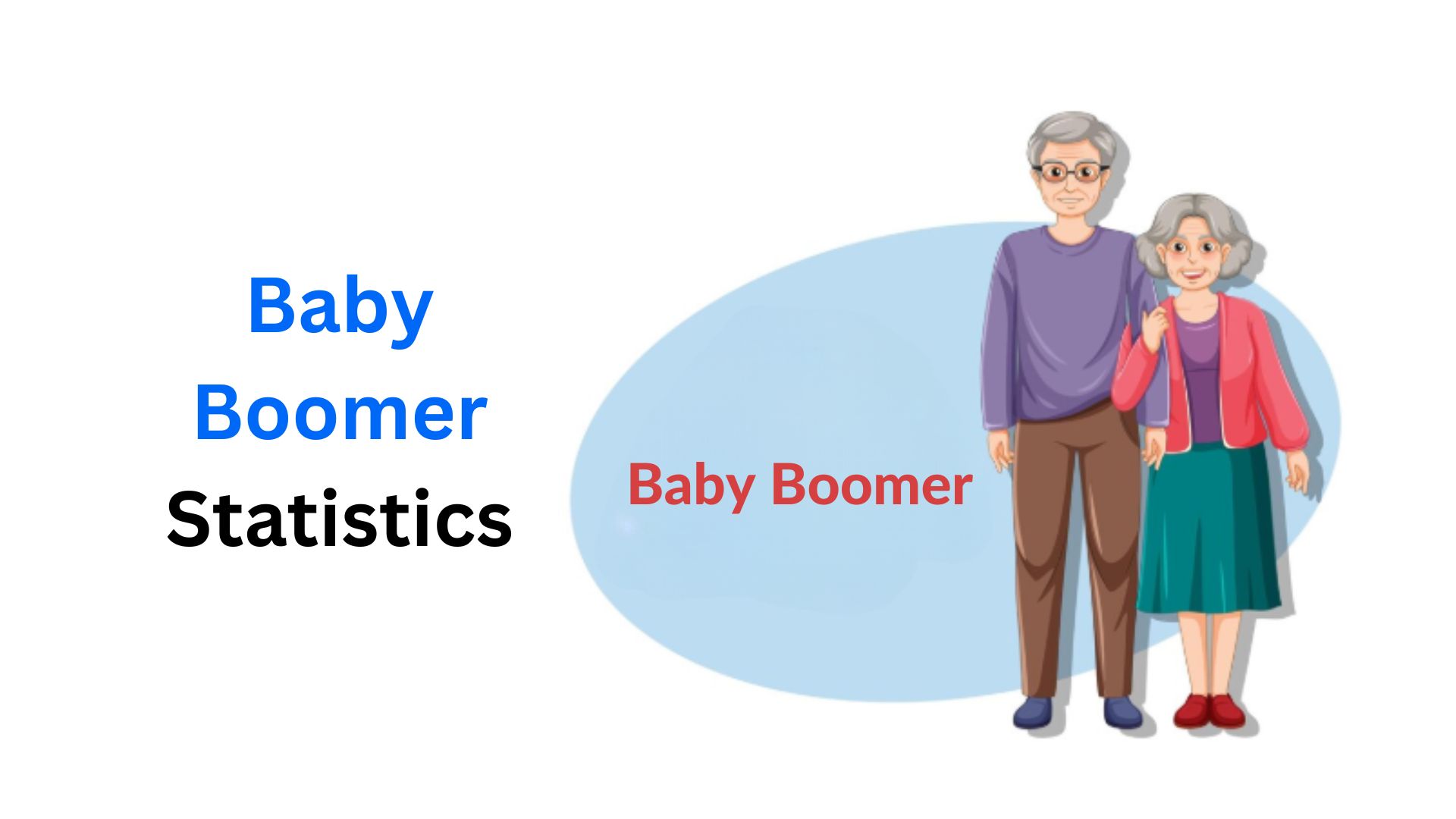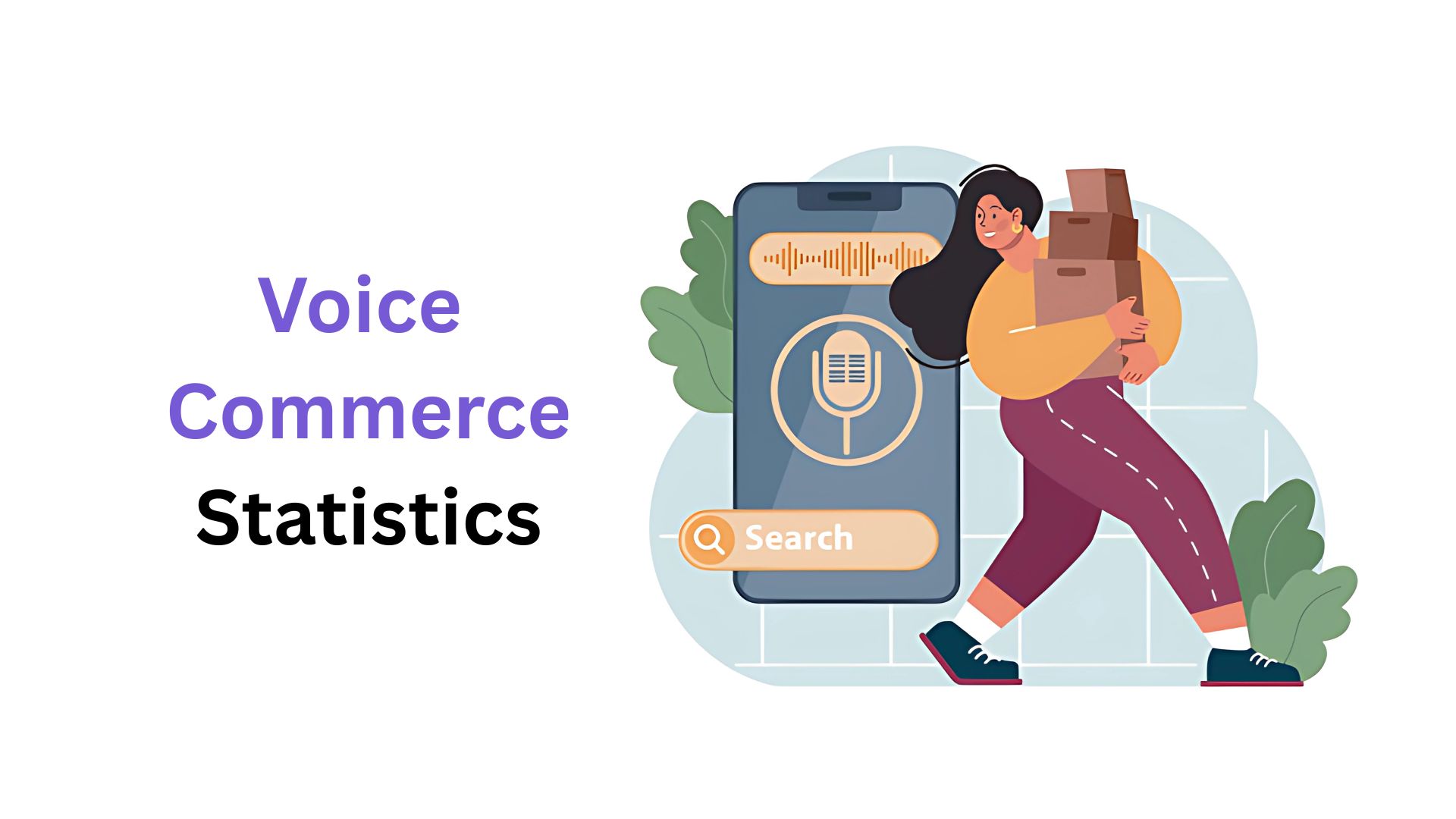Mental Health Statistics By Countries, Respondents And Expenditure
Updated · Nov 18, 2024

Table of Contents
- Introduction
- Editor’s Choice
- Leading Health Problems Worldwide
- Adults Thinking of Mental And Physical Well-Being
- Respondents Feel The Importance of Mental Health
- Respondents Who Feel Mental Health is Essential
- Share of Population with Mental Health Disorder
- Most Stressed Countries
- Does Mental Health Care Matters?
- Population With Anxiety Disorders
- Mental Health Expenditure By Country
- Share of Mental Health Programs
- Antidepressant Consumption Among Countries
- Cost-related Issues Among Adults About Mental Health
- Rate of Global Mental Health Workforce
- Effect Of Mental Illness Statistics
- Mental Health Apps Statistics
- Popular Mental Health Support Groups
- General Mental Health Statistics
- Mental Health Overview
- Conclusion
Introduction
Mental Health Statistics: Mental health refers to the emotional and psychological aspects of social health and well-being. The World Health Organization states it to be a condition where an individual can deal with the daily stress of life and work fruitfully without compromising on health. For the most part, it is an essential aspect that needs to be addressed to ensure holistic well-being.
Likewise, we will go through the Mental Health Statistics and learn about the relevant elements of this health topic and learn more about it.
Editor’s Choice
- 50% of all lifetime mental illness begins by age 14, and 75% by age 24.
- 1 in 5 U.S. adults (20%) experience mental illness each year.
- 1 in 6 U.S. youth aged 6-17 (16.7%) experience a mental health disorder each year.
- 1 in 20 U.S. adults (5%) experience serious mental illness each year.
- Suicide is the 2nd leading cause of death among people aged 10-14.
- Mental health is the leading health problem globally, affecting 45% of respondents.
- Anxiety disorders saw a significant spike post-COVID-19, reaching 4.4% globally in 2022.
- Low-income countries prioritize mental health over physical health at 58%, compared to 28% in higher-income countries.
- The U.S. has the highest cost-related access issues for mental health services at 26%.
- Mental health awareness programs constitute 18% of all global mental health initiatives.
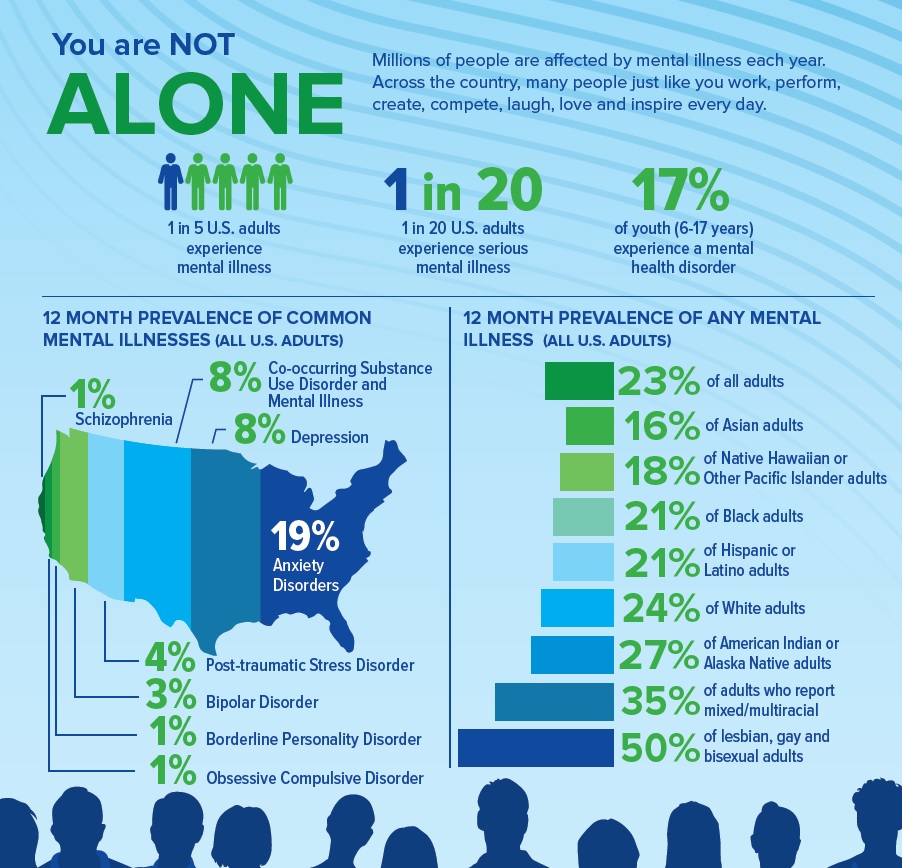
(Source: nami.org)
- In 2021, 22.8% of U.S. adults experienced mental illness, affecting 57.8 million people.
- In 2021, 5.5% of U.S. adults experienced serious mental illness, affecting 14.1 million people.
- In 2016, 16.5% of U.S. youth aged 6-17 experienced a mental health disorder, affecting 7.7 million people.
- In 2021, 7.6% of U.S. adults experienced a co-occurring substance use disorder and mental illness, affecting 19.4 million people.
- Annual prevalence of mental illness among U.S. adults by demographic group:
- Non-Hispanic mixed/multiracial: 34.9%.
- Lesbian, Gay, or Bisexual: 50.2%.
- Non-Hispanic American Indian or Alaska Native: 26.6%.
- Non-Hispanic White: 23.9%.
- Non-Hispanic Black or African American: 21.4%.
- Hispanic or Latino: 20.7%.
- Non-Hispanic Native Hawaiian or Other Pacific Islander: 18.1%.
- Non-Hispanic Asian: 16.4%.
- Annual prevalence of specific mental health conditions among U.S. adults:
- Anxiety Disorders: 19.1%.
- Major Depressive Episode: 8.3%.
- Posttraumatic Stress Disorder: 3.6%.
- Bipolar Disorder: 2.8%.
- Borderline Personality Disorder: 1.4%.
- Obsessive-Compulsive Disorder: 1.2%.
- Schizophrenia: less than 1%.
Leading Health Problems Worldwide
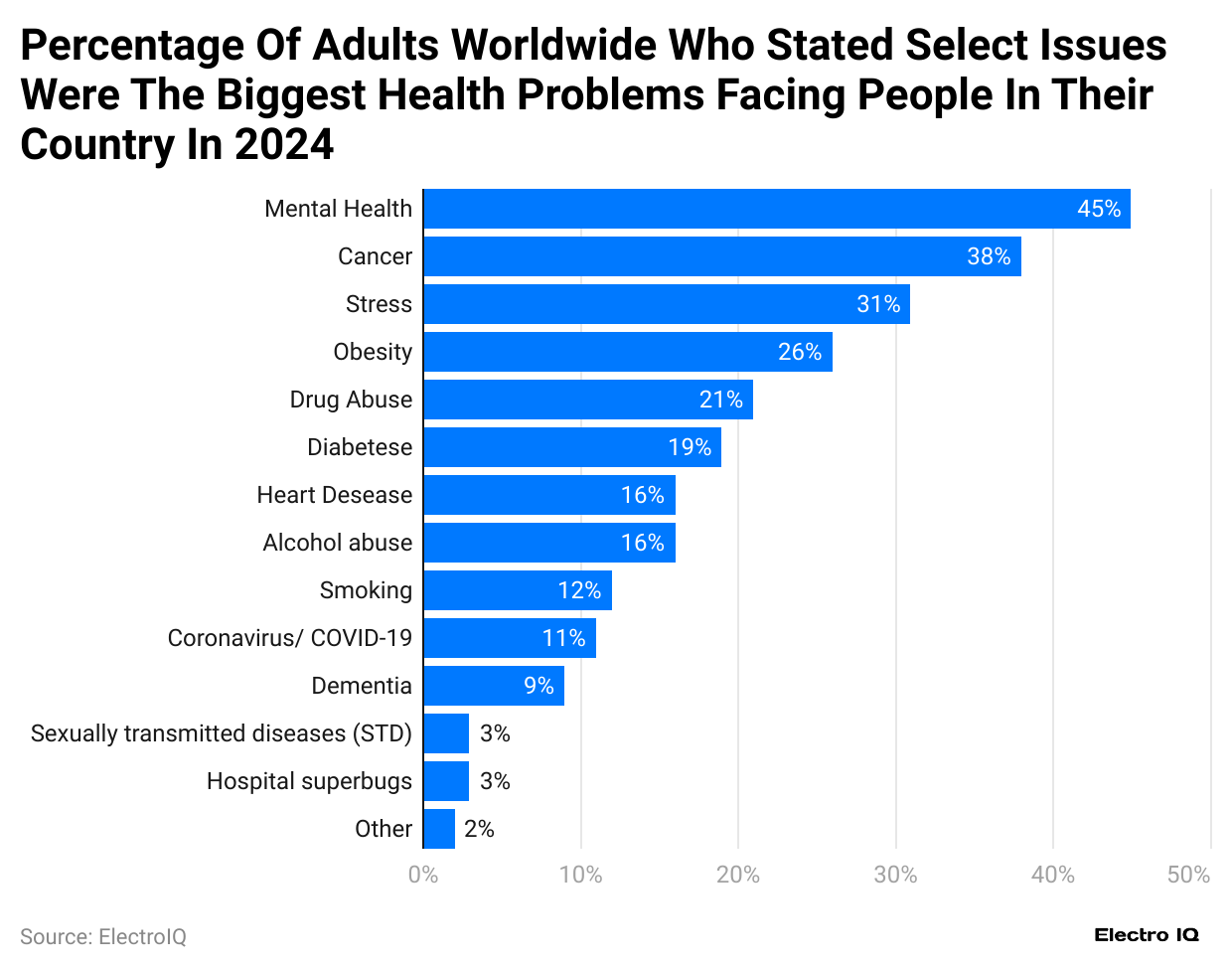
(Reference: statista.com)
- Mental Health Statistics show that mental health is the leading health problem globally among 45% of respondents.
- It is followed by Cancer at 38%, Stress at 31%, Obesity at 26%, Drug abuse at 21%, and Diabetes at 19%.
Adults Thinking of Mental And Physical Well-Being
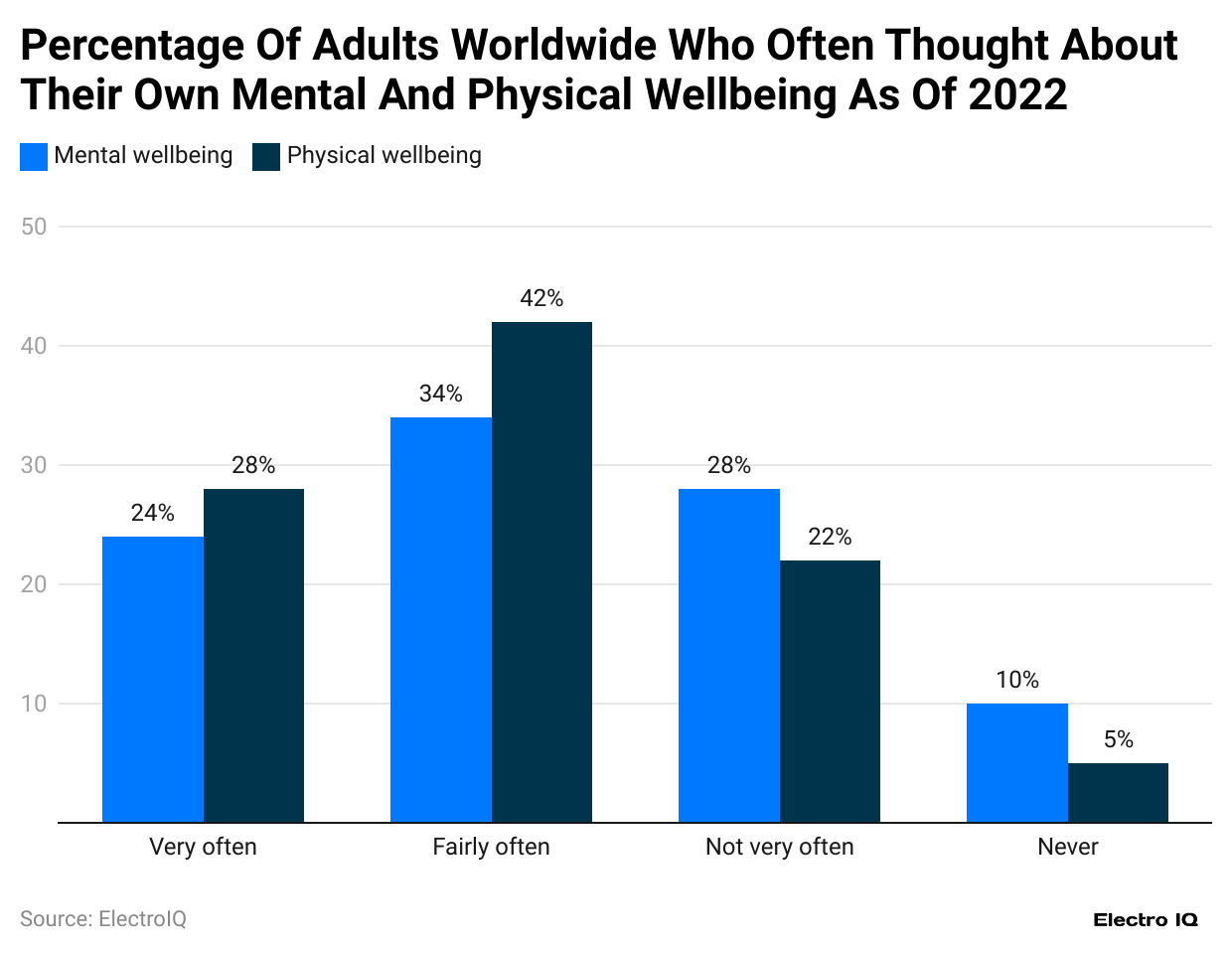
(Reference: statista.com)
- Mental Health Statistics show that a majority of adults worldwide thought about their physical well-being more frequently than their mental well-being,
- 42% of users think about physical health and well-being, and 34% think about mental well-being.
- 10% of users never think of mental well-being, and 5% don’t think about physical well-being.
Respondents Feel The Importance of Mental Health
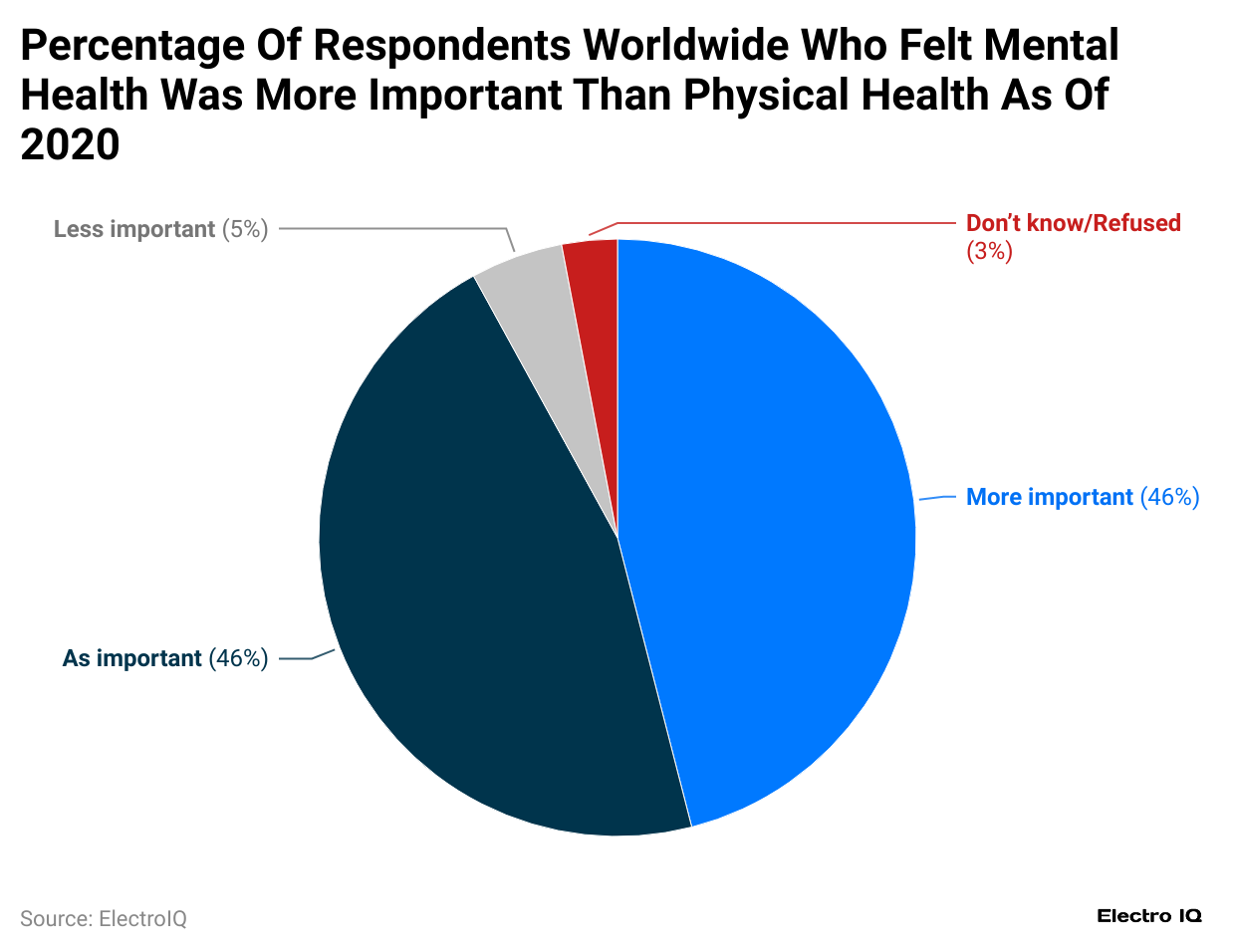
(Reference: statista.com)
- Mental Health Statistics show that 46% of respondents find it the most important part of mental health.
- It is followed by 46% as important, 5% less important, and 3% who don’t know and refused.
Respondents Who Feel Mental Health is Essential
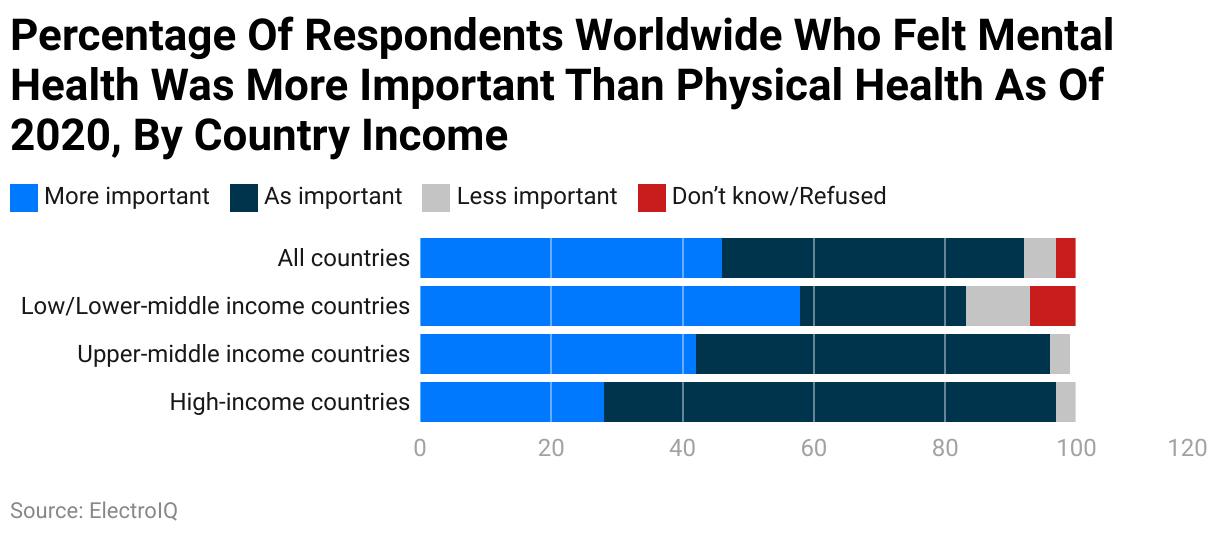
(Reference: statista.com)
- Mental Health Statistics show that low-income countries prioritized mental health over physical health more than higher-income countries, where respondents tended to see both as equally important.
- In low/lower-middle-income countries, 58% of respondents felt mental health was more important than physical health, significantly higher than other income groups.
- In high-income countries, only 28% prioritized mental health over physical health, while 69% considered them equally important.
- Across all countries, 46% of respondents viewed mental health as more important, and another 46% valued both equally.
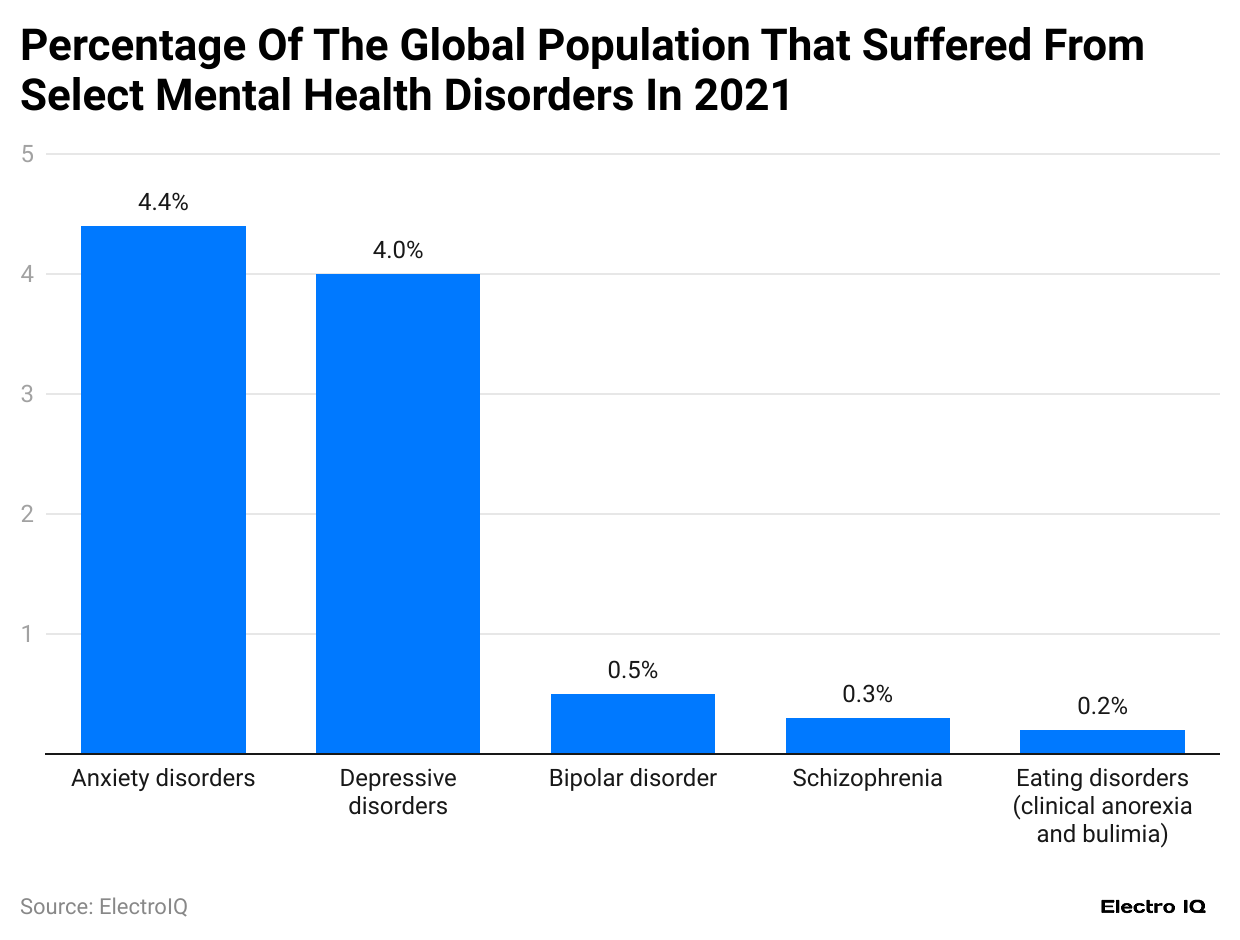
(Reference: statista.com)
- Mental Health Statistics show that Schizophrenia, Bipolar disorder, Anxiety disorders, Eating disorders (clinical anorexia and bulimia), and Depressive disorders are different mental health disorders.
- 4% of users suffered from anxiety disorders, 4% had depressive disorders, 0.5% had bipolar disorders, 0.3% had schizophrenia, and 0.2% had eating disorders.
Most Stressed Countries
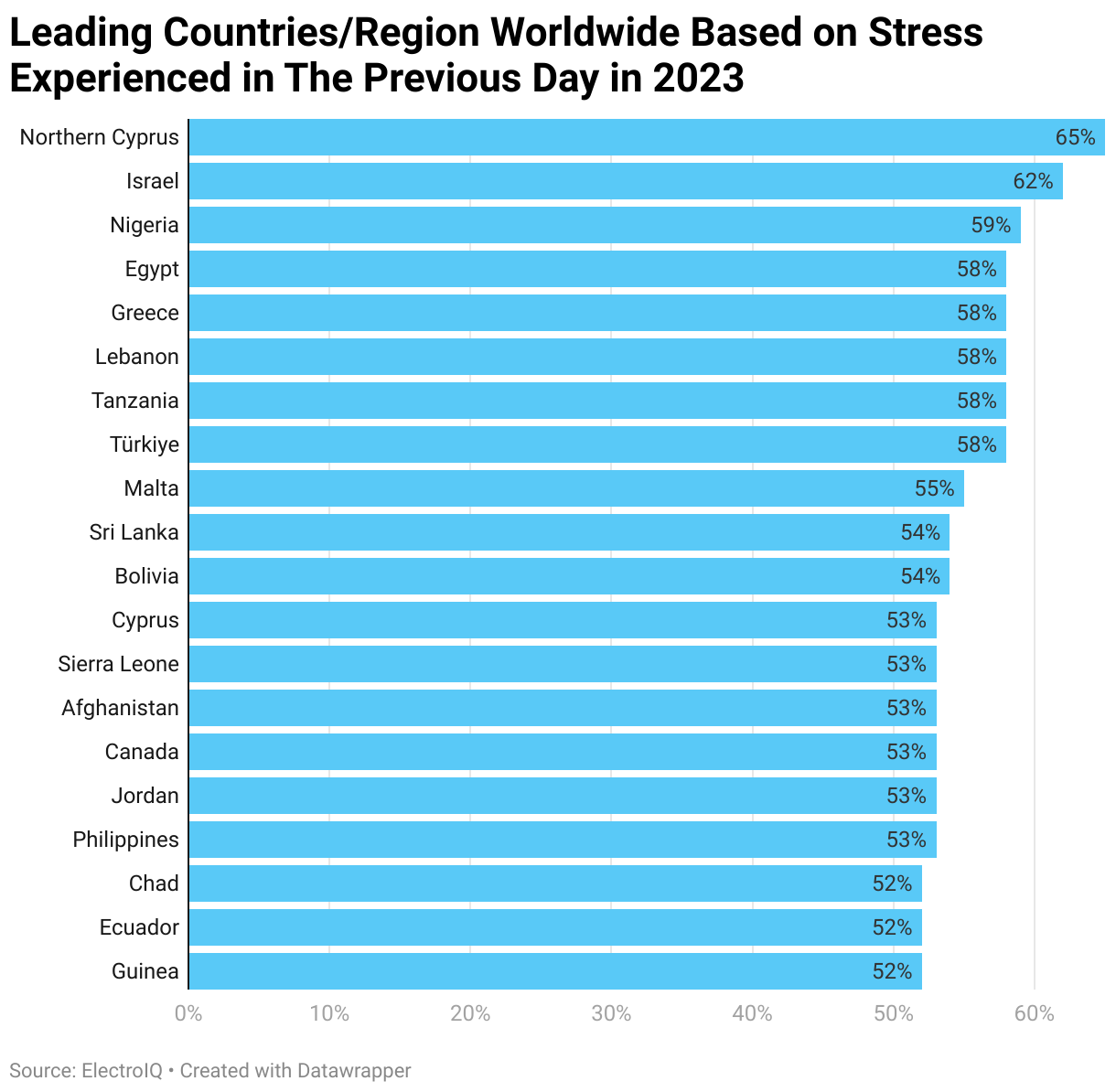
(Reference: statista.com)
- Mental Health Statistics show that stress is a significant issue across various countries.
- Northern Cyprus leads with 65% of respondents experiencing stress, followed by Israel at 62% Nigeria, Egypt, Greece, Lebanon, and Tanzania at 58%.
Does Mental Health Care Matters?
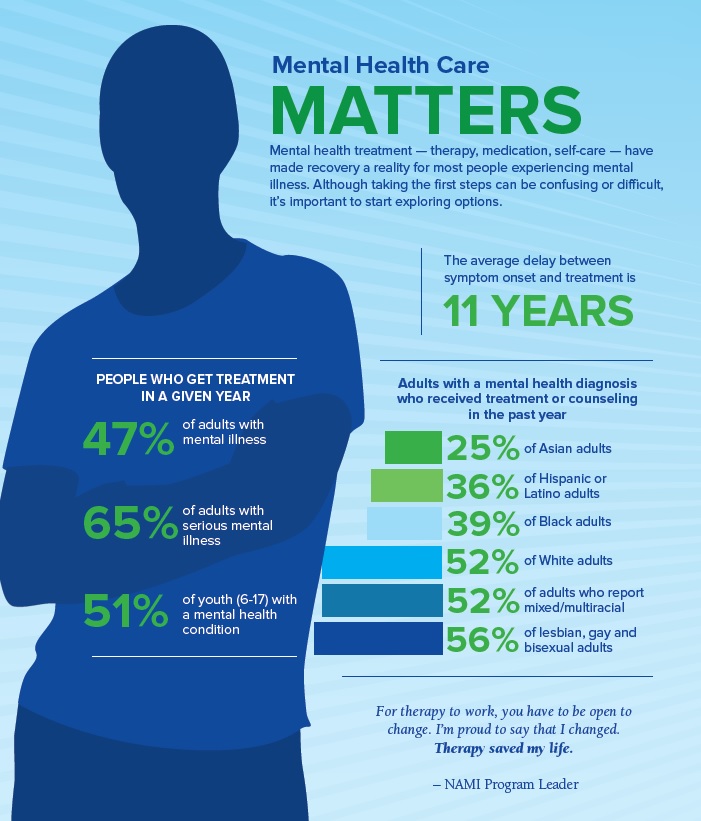
(Source: nami.org)
- 160 million people in the United States live in a designated Mental Health Professional Shortage Area.
- 47.2% of U.S. adults with mental illness received treatment in 2021.
- 65.4% of U.S. adults with serious mental illness received treatment in 2021.
- 50.6% of U.S. youth aged 6-17 with a mental health disorder received treatment in 2016.
- The average delay between the onset of mental illness symptoms and treatment is 11 years.
- 55.6% of lesbian, gay, or bisexual U.S. adults with mental illness received treatment in 2021.
- 52.4% of non-Hispanic White adults with mental illness received treatment in 2021.
- 52.2% of non-Hispanic mixed or multiracial adults with mental illness received treatment in 2021.
- 51.7% of females with mental illness in the United States received treatment in 2021.
- 40% of males with mental illness in the United States received treatment in 2021.
- 39.4% of non-Hispanic Black or African American adults with mental illness received treatment in 2021.
- 36.1% of Hispanic or Latino adults with mental illness received treatment in 2021.
- 25.4% of non-Hispanic Asian adults with mental illness received treatment in 2021.
- 10.6% of U.S. adults with mental illness had no insurance coverage in 2021.
- 11.9% of U.S. adults with serious mental illness had no insurance coverage in 2021
Population With Anxiety Disorders
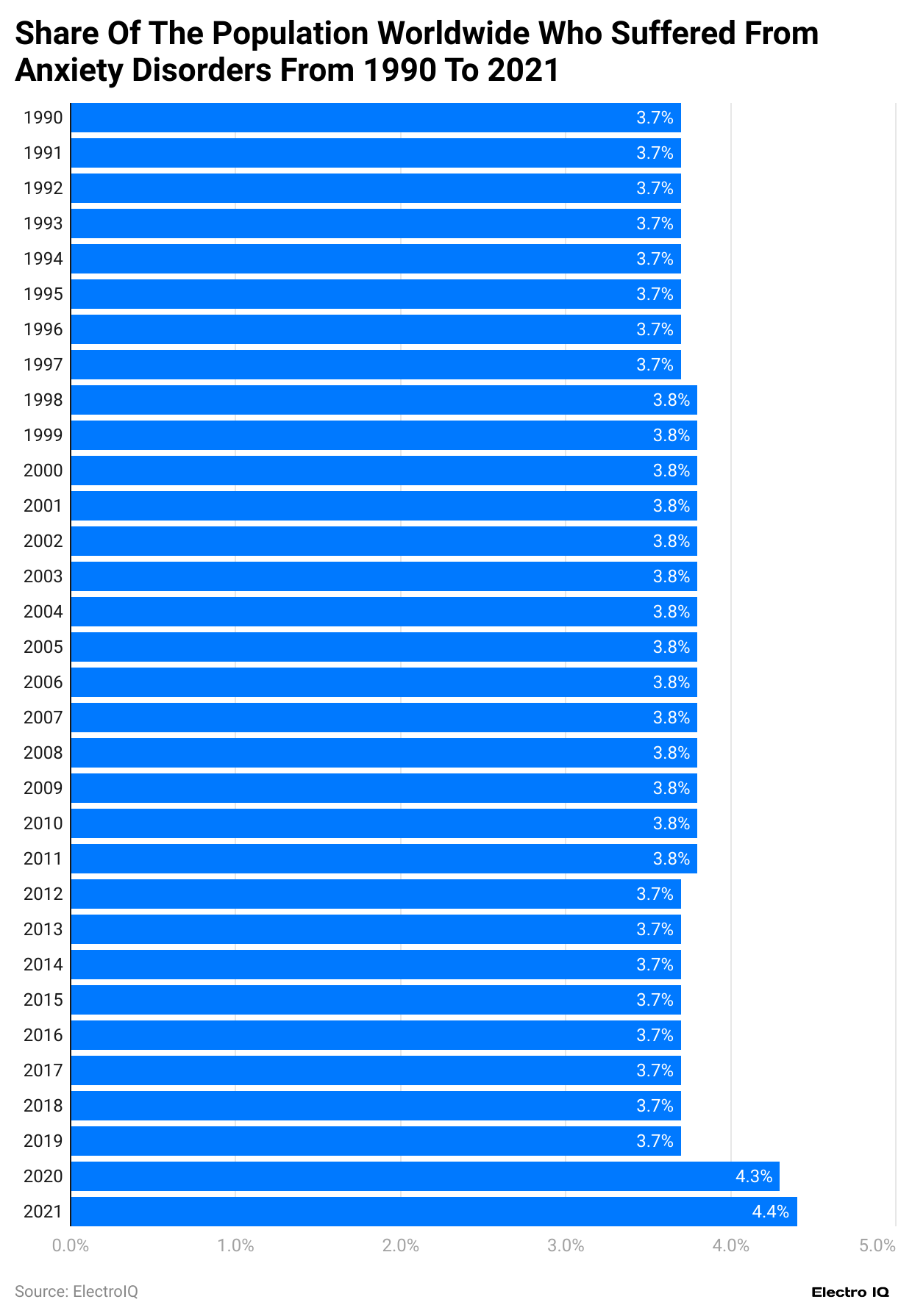
(Reference: statista.com)
- Mental Health Statistics show that Anxiety disorders affect a consistent portion of the global population.
- From 1990 to 2020, the global share of the population suffering from anxiety disorders remained relatively stable, fluctuating between 1.7% and 1.8%.
- Post covid in 2021 and 2022, there has been a spike in anxiety disorders with 4.3% and 4.4%.
Mental Health Expenditure By Country
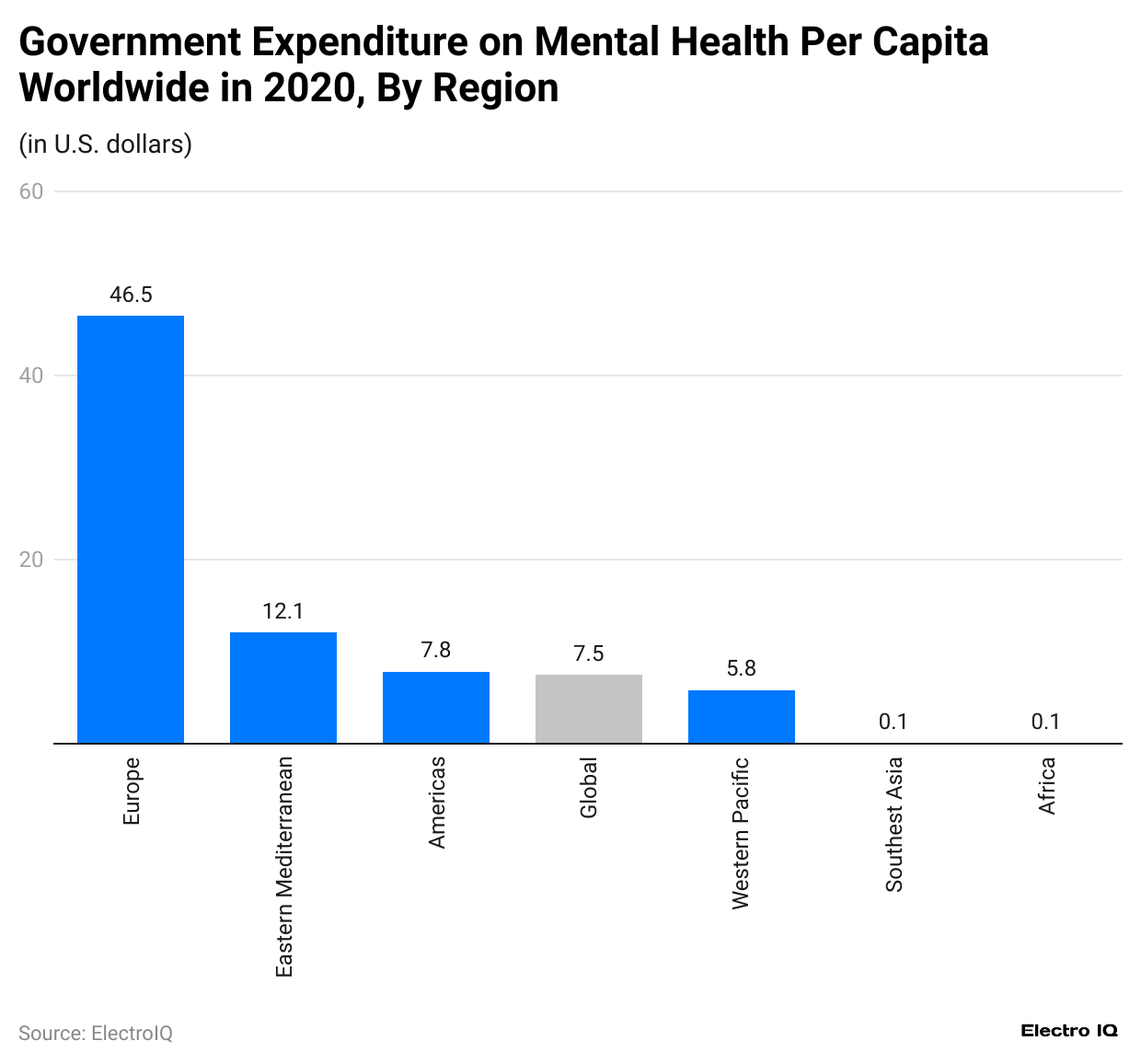
(Reference: statista.com)
- Mental Health Statistics show varied expenditure on mental health in different regions.
- Europe has the highest expenditure, with $46.49 per capita, followed by the Eastern Mediterranean, which has $12.08; the Americas, which has $7.49; and the Western Pacific, with $5.81.
- South East Asia and Africa have the lowest government expenditure on mental health, with $0.1 per capita, while the global average is %7.49.
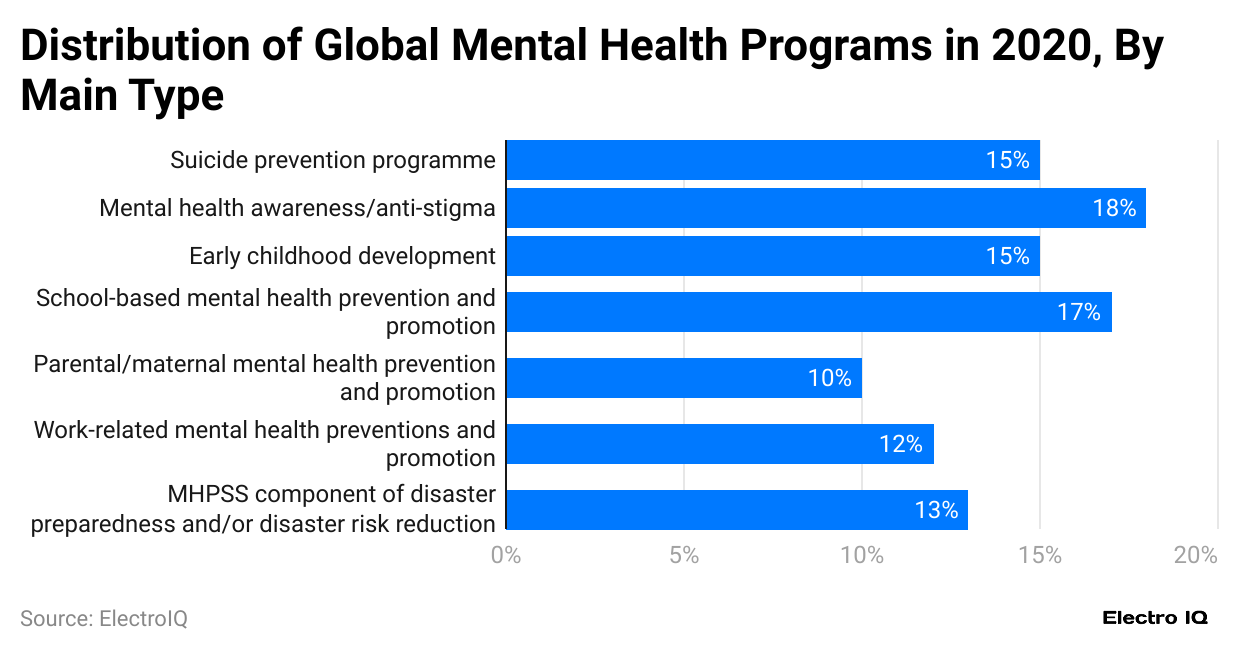
(Reference: statista.com)
- Mental Health Statistics show that there are mental health initiatives globally focused primarily on awareness and anti-stigma efforts, with considerable attention also given to schools and early childhood, underscoring a preventive approach.
- Mental health awareness and anti-stigma programs were the most common type of global mental health initiative in 2020, making up 18% of all programs.
- Parental and maternal mental health programs were less common, comprising only 10% of total programs.
Antidepressant Consumption Among Countries
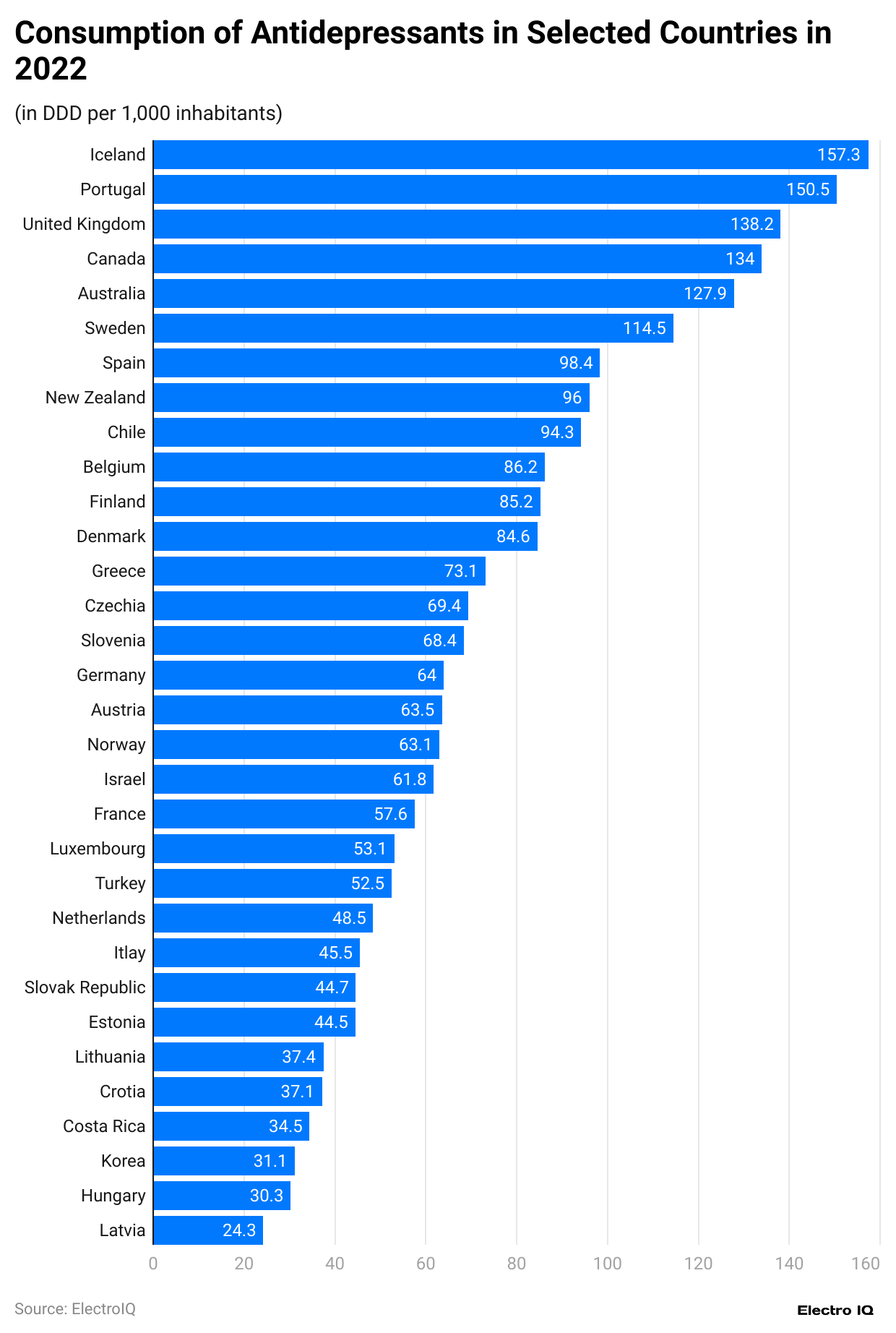
(Reference: statista.com)
- Mental Health Statistics show that Iceland has the highest consumption of antidepressants, with 157.3 DDD per 1000 people.
- Portugal follows it with 150.5 DDD per 1000 people, the United Kingdom with 138.2 DDD per 1000 people, Canada with 134 DDD per 1000 people, Australia with 127.9 DDD per 1000 people, and Sweden with 114.5 DDD per 1000 people.
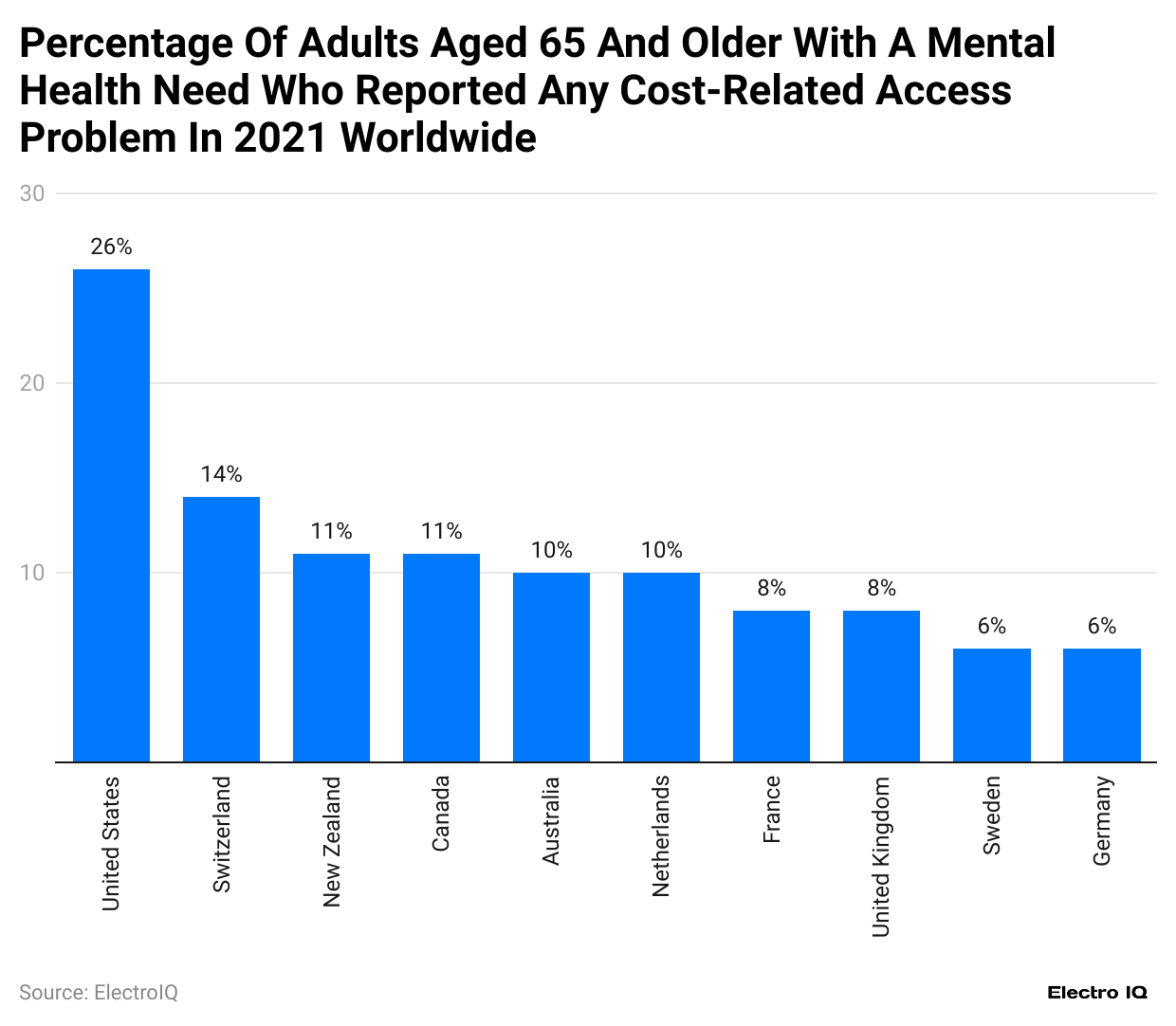
(Reference: statista.com)
- Mental Health Statistics show that among different countries, the United States has the highest number of respondents who feel they have cost-related access problems concerning mental health, with 26%.
- Countries like Sweden and Germany are doing relatively well, with 6% of respondents feeling they have cost-related issues about access to mental health.
Rate of Global Mental Health Workforce
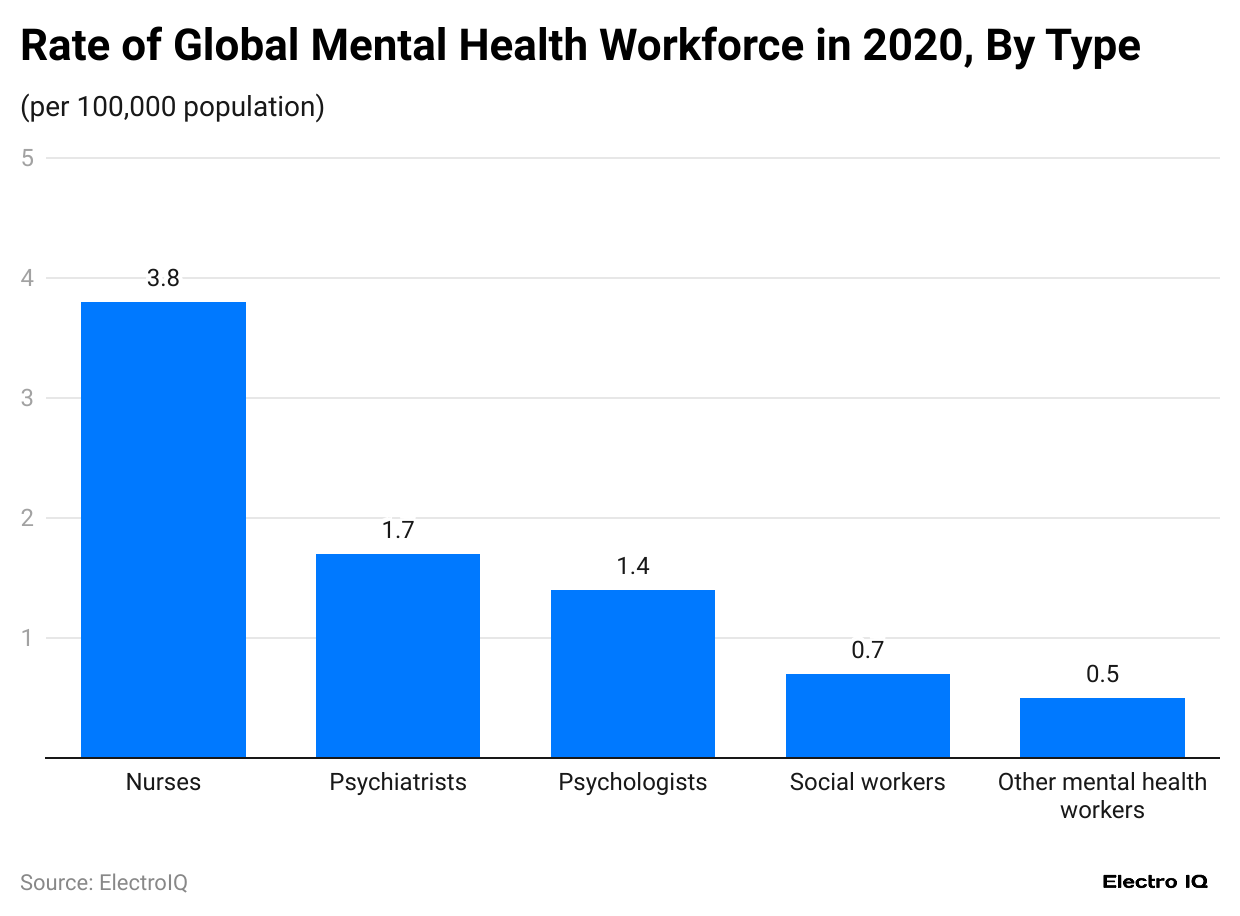
(Reference: statista.com)
- Mental Health Statistics show nurses have the highest proportion among workers, with 3..8 per lakh population.
- In contrast, social workers and other mental health workers have the lowest proportion, 0.7 and 0.5 per lakh population.
Effect Of Mental Illness Statistics
- Depression and anxiety disorders annually cost the global economy USD 1 trillion in lost productivity.
- Serious mental illness results in USD 193.2 billion in lost earnings annually across the U.S. economy.
- Approximately 21.1% of individuals experiencing homelessness in the U.S. have a serious mental health condition.
- In 2021, 33.5% of U.S. adults with mental illness also experienced a substance use disorder, affecting 19.4 million individuals.
- Individuals with serious mental illness are nearly twice as likely to develop cardiovascular and metabolic conditions compared to those without mental illness.
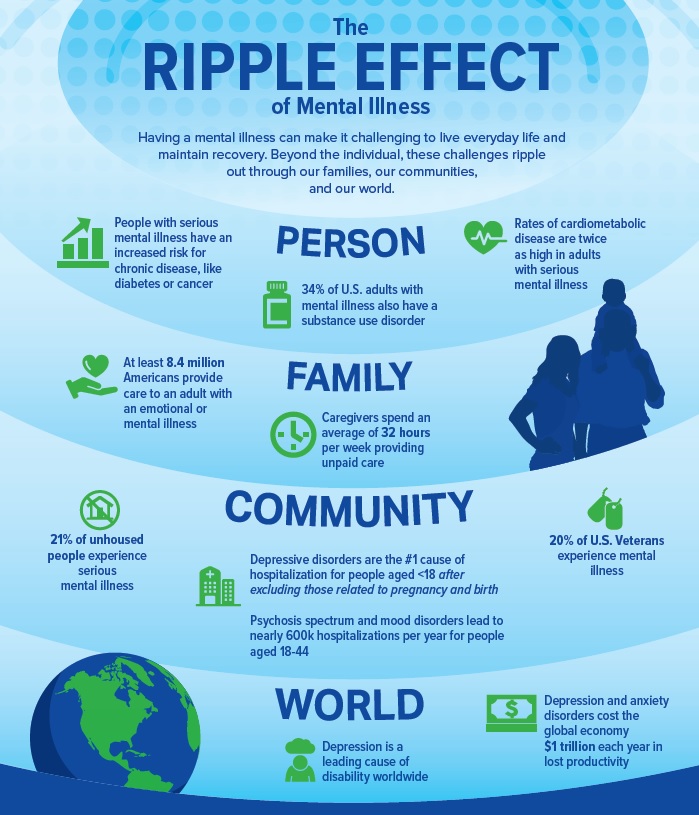
(Source: nami.org)
- People with depression have a 40% higher risk of developing cardiovascular and metabolic diseases than the general population.
- The unemployment rate for U.S. adults with mental illness was 7.4% compared to 4.6% for those without mental illness.
- High school students exhibiting significant symptoms of depression are more than twice as likely to drop out of school compared to their peers.
- Students aged 6-17 with mental, emotional, or behavioral concerns are three times more likely to repeat a grade than their classmates.
- At least 8.4 million individuals in the U.S. provide care to an adult dealing with a mental or emotional health issue.
- Caregivers of adults with mental or emotional health issues spend an average of 32 hours per week on unpaid care.
- In 2020, 19.7% of U.S. Veterans, representing 3.9 million individuals, experienced a mental illness.
- Among U.S. individuals under 18, depressive disorders are the most common cause of hospitalization outside of pregnancy and birth-related cases.
- In 2021, 9.6% of Active Component service members in the U.S. military experienced a mental health or substance use condition.
- Among U.S. adults aged 18-44, psychosis spectrum and mood disorders result in nearly 600,000 hospitalizations each year.
Mental Health Apps Statistics
![]()
- The Mental Health Apps Market is expected to grow from USD 6.3 billion in 2023 to USD 26.2 billion by 2033, reflecting a CAGR of 15.3% during the forecast period from 2024 to 2033.
- In 2023, the market generated revenue of USD 6.3 billion.
- The iOS platform accounted for a market share of 61.2% in 2023.
- Depression and anxiety management applications captured a significant share of 42.3% within the market.
- Home care settings emerged as the leading end-user segment, representing 54.3% of the total revenue in 2023.
- North America dominated the regional market with a share of 38.7% in 2023.
Popular Mental Health Support Groups
- BoyChat
- The Indian Stammering Association
- Diabetes Hands Foundation
- PatientsLikeMe
- Wrong Planet
- HealthUnlocked
- Virtuous Pedophiles
- Trusera
- HealthBoards
- Webicina
- DailyStrength
- Understanding Sexuality, Gender, and Allyship
- Netmums
- North Star (organization)
- Online health communities
- IMedix
- 1in6
- BPDFamily.com
(Source: wikipedia.org)
General Mental Health Statistics
- Mental health disorders, such as major depression, bipolar disorder (manic depression), schizophrenia, and obsessive-compulsive disorder, are among the leading causes of disability in established market economies, including the United States.
- Approximately 26% of Americans aged 18 and older, or about 1 in 4 adults, experience a diagnosable mental disorder each year.
- Around 18% of individuals aged 18 to 54 experience an anxiety disorder annually, which includes conditions like panic disorder, OCD, PTSD, generalized anxiety disorder, and phobias.
- Approximately 9.5% of American adults aged 18 and over experience a depressive illness each year, including major depression, bipolar disorder, or dysthymia.
- Bipolar disorder affects 2.6% of Americans aged 18 and older annually, with the average onset of a first manic episode occurring in the early 20s.
- Schizophrenia affects about 1% of Americans, typically first appearing in men during their late teens or early 20s and in women during their 20s or early 30s.
- About 5% of the U.S. adult population, or approximately 12.8 million people, reported experiencing serious thoughts of suicide in 2021-2022.
- Suicide rates are highest among Caucasian men over the age of 85. It is also a leading cause of death among adolescents and young adults aged 15 to 24.
- Four times as many men as women commit suicide, but women attempt suicide more frequently.
- One in five youth reported having at least one major depressive episode in the past year, with over half not receiving treatment. Among those who were treated, only 65% reported that the treatment was helpful.
- Approximately 13% of youth aged 12 to 17 reported experiencing serious thoughts of suicide, with the highest rates among Native Hawaiian or other Pacific Islander youth at 25% and youth identifying as more than one race at 20%.
- About 18% of U.S. adults experienced a substance use disorder in the past year; however, 77% of those individuals did not receive treatment. Additionally, around 9% of youth had a substance use disorder in the past year, with a higher prevalence of drug issues (7%) compared to alcohol issues (3%).
- The average age of onset for major depression is in the mid-20s, while panic disorder typically develops in late adolescence or early adulthood. The first symptoms of OCD often begin during childhood or adolescence, and generalized anxiety disorder can begin at any time, with the highest risk occurring between childhood and middle age.
- Approximately 10% of adults with mental illness are uninsured. Cost is a significant barrier to treatment, with 25% of adults experiencing frequent mental distress unable to see a doctor due to cost, representing a 2% increase from previous reports. In 2022, 64% of uninsured adults stated they could not afford health insurance.
- Around 10% of adults and 8.5% of youth with private insurance lack coverage for mental health services.
- About 0.67% of students are identified as having emotional disturbances that qualify for an Individualized Education Program (IEP). From 2019 to 2021, the percentage of students identified with emotional disturbances for an IEP decreased in most states, except in Wyoming, Texas, and South Dakota.
- There are 340 people for every mental health provider in the U.S., although this figure may overestimate the number of active practitioners.
- In 2021-2022, 23% of adults experienced a mental illness, which is nearly 60 million Americans. The number of suicide deaths in 2022 was the highest ever recorded in the U.S.
- Approximately 60.5% of youth in the U.S. are flourishing, linked to positive outcomes like school engagement. The highest percentages of flourishing youth were reported in Georgia, Illinois, and Hawaii.
Mental Health Overview
- In 2023, an estimated 20% of adults worldwide reported experiencing a mental health condition, such as anxiety, depression, or stress-related disorders.
- Approximately 21% of adults in the United States, equating to 53 million people, experienced some form of mental illness in 2023.
- The economic cost of untreated mental health disorders in the United States exceeded USD 300 billion per year, driven by lost productivity, absenteeism, and healthcare expenses.
- Globally, mental health conditions cost the economy USD 1 trillion annually in lost productivity as of 2023.
- In 2023, US companies invested an estimated USD 4.5 billion in workplace mental health programs and wellness initiatives. This spending is projected to reach USD 5 billion in 2024.
- Employees with access to mental health resources showed a 25% increase in productivity and 30% higher job satisfaction, significantly reducing turnover rates.
- Around 15% of adolescents aged 12 to 17 in the United States reported experiencing at least one major depressive episode in 2023.
- The rate of anxiety and depression among teenagers has increased by 20% over the past decade, driven by factors like social media influence, academic pressures, and global uncertainties.
- In 2023, approximately 50% of schools in the United States had mental health counselors or social workers. This percentage is expected to rise, with school-based mental health services receiving an additional USD 100 million in funding in 2024.
- In 2023, 15% of people aged 65 and older in the United States experienced mental health issues, including depression and anxiety.
- By 2024, the United States is projected to have 56 million people aged 65 and older, with USD 500 million allocated to elderly mental health programs focusing on community support, counseling services, and caregiver training.
- Teletherapy accounted for 35% of all therapy sessions in the United States in 2023. Adoption is expected to increase further in 2024, with 78% of users reporting positive experiences.
- In 2023, digital mental health services generated USD 1.5 billion in global revenue. This is projected to increase to USD 1.8 billion by 2024.
- The global mental health services market was valued at USD 500 billion in 2023 and is projected to grow by 6% annually, reaching USD 530 billion in 2024.
- Approximately 60% of health insurance plans in the United States covered mental health services, such as therapy and medication, in 2023. This is expected to rise to 65% in 2024, making services more affordable and accessible.
- About 70% of Americans in 2023 felt more comfortable discussing their mental health than in previous years, leading to a 15% increase in individuals seeking mental health services.
- Mental health apps, a significant segment of digital mental health, have become widely adopted, reflecting the increasing preference for convenient and affordable support.
- In 2023, 80% of companies with over 500 employees in the United States offered mental health support, such as Employee Assistance Programs or counseling services. This number is expected to rise to 85% in 2024.
- One in five children in the United States was diagnosed with a mental health disorder, such as anxiety, ADHD, or depression, in 2023.
- The stigma surrounding mental health is steadily diminishing, driven by awareness campaigns and educational initiatives by organizations like NAMI and Mental Health America.
- In 2023, schools and educational institutions increasingly adopted mental health programs, with 60% of US high schools expected to implement such initiatives by 2024, benefiting nearly 20 million students.
Conclusion
The comprehensive analysis of mental health statistics reveals a growing global awareness and prioritization of mental health issues. The contrast between high-income and low-income countries in prioritizing mental health, combined with varying levels of government expenditure, highlights global disparities in mental health care access. The rise of digital solutions, including teletherapy and mental health apps, represents an evolving care delivery landscape.
Furthermore, there is a need for continued investment in mental health infrastructure, reduced stigma, and improved insurance coverage to address the growing global mental health crisis effectively.
FAQ.
As of 2022, 4.4% of the global population experiences anxiety disorders
Iceland leads with 157.3 DDD per 1,000 people.
Approximately 20% of adults worldwide reported experiencing a mental health condition in 2023.
Mental health conditions cost the global economy $1 trillion in lost productivity annually
Europe leads with $46.49 per capita in mental health expenditure
About 21% of US adults (approximately 53 million people) suffer from some form of mental illness

Joseph D'Souza founded ElectroIQ in 2010 as a personal project to share his insights and experiences with tech gadgets. Over time, it has grown into a well-regarded tech blog, known for its in-depth technology trends, smartphone reviews and app-related statistics.





